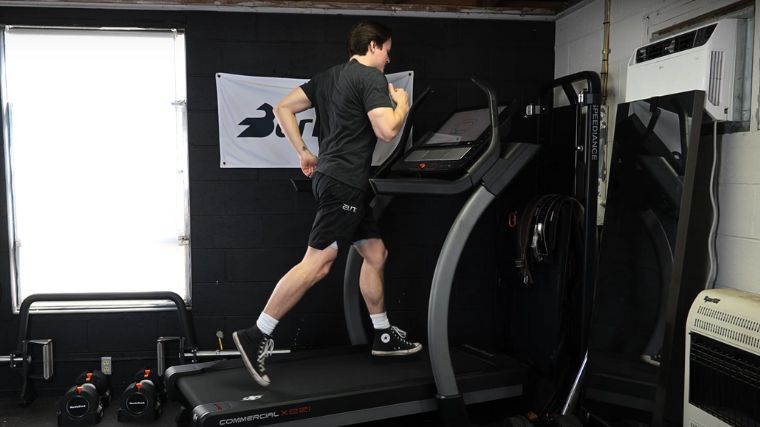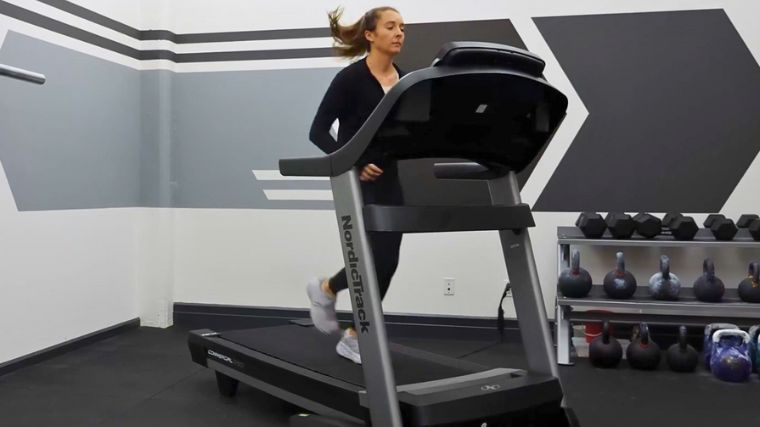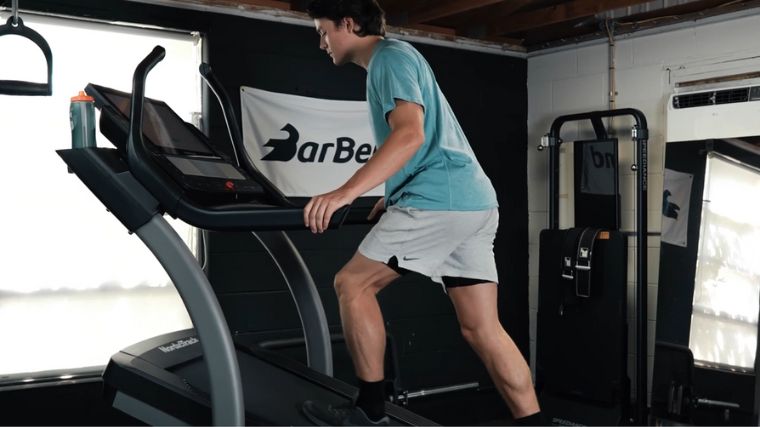Almost by its very definition, a marathon is an exhibition of outdoor running endurance. The very first marathon — run by Pheidippides — was a 26-mile jaunt across the hilly Grecian terrain from Marathon to Athens. So, whenever you hit the starting line on race day and wish the runners next to you a hearty “Good luck!”, you’re engaging in one of running’s most storied traditions.

On the other hand, Pheidippides didn’t own a treadmill, and if he had trained with one ahead of time, he might not have collapsed and died from exhaustion when he finally reached Athens. So that begs the question: Can you rely on treadmill training to adequately prepare for a marathon? Also, even if you can run outside, can treadmill running still improve upon your marathon training plan? I asked a running coach, and came back with the best tips for you.
Editor’s Note: The content on BarBend is meant to be informative in nature, but it should not be taken as medical advice. When starting a new training regimen and/or diet, it is always a good idea to consult with a trusted medical professional. We are not a medical resource. The opinions and articles on this site are not intended for use as diagnosis, prevention, and/or treatment of health problems. They are not substitutes for consulting a qualified medical professional.
How to Train for a Marathon on a Treadmill
With a few small tweaks, the same sort of outdoor workout program that can get you in shape for a half marathon or a marathon can be adapted for treadmill running. This means if you can string together the right sequence of training runs, the conditioning of your body will be similar to if you had trained outdoors.
Use More Inclines
Asphalt and concrete are very unforgiving on your knees, along with the muscles in your quads, glutes, and hamstrings. It can be difficult to get used to 26.2 miles of impact with hard pavement by running on the softer surface of the treadmill. To prepare for this to at least some degree, Whitaker suggests inserting a lot of treadmill incline workouts into your running routine.
“You’ll want to up the incline on a regular basis,” advises Whitaker. “You’ll want more steady-state climbs, also with some varying inclines. The inclines would work a wider variety of different muscles that don’t get worked when the treadmill is perfectly flat all the time. This also takes your body through a wider variety of metabolic states as your heart rate goes up and down.”
Use Five Focus Areas
Whitaker recommends that you separate your marathon training into macrocycles with five different areas of focus that will prepare you for every punishing aspect of running a marathon. The specifics of the focus areas may vary in terms of their length, volume, and intensity, with experienced runners opting for longer, harder, and more frequent runs.
The marathon training phases he recommends are:
- Transition: “The transition phase is when you’re coming off a period of recovery or low mileage, and you’re building a fitness base to handle higher mileage.”
- Aerobic Capacity: “The aerobic capacity phase builds your mileage safely by leveraging aerobic threshold runs to increase aerobic capacity.”
- Aerobic Strength: “In the aerobic strength phase, you’ll add tempo, interval running workout, and strength work.”
- Specific Endurance: “The specific endurance phase marks one of the longer phases where you focus on paces to prepare your body for the rigors of the marathon.”
- Peaking: “Then you have the peaking phase, where you practice your racing speed at reduced volume, along with your nutrition, rest, and recovery.”
Vary Your Weekly Plan
In addition to taking your training in phases, you’ll train with different strategies throughout each week, too. This includes tempo runs, interval training, various types of speed work, and also strength training off of the treadmill. Your overall focus will be different during different phases, but you’ll still need this kind of variety.
Here’s what Whitaker says a typical week might look like for an experienced runner training for a marathon. If your body isn’t yet accustomed to this volume, start smaller and integrate more rest times. Regardless of your experience level, if this volume is too intense, scale it back.
- Monday: Short aerobic run
- Tuesday: Speed intervals and race-based training
- Wednesday: Mid-distance aerobic run
- Thursday: Cross-training day with strength training
- Friday: Lactate threshold and critical velocity training
- Saturday: Long aerobic run
- Sunday: Recovery day with walking or short run at an easy pace
Steadily Increase Your Mileage
Whether you train for your marathon with outdoor running, indoor running, or treadmill running, the heart of your training is high mileage. Total training mileage is one of the strongest predictors of distance running performance. (1) It’s essential for your training plan to include a gradual escalation of the lengths and total volume of your runs, and your training sessions should directly account for these needs.

[Read More: How To Sprint Like a Pro, + Tips From a Collegiate S&C Coach]
“A 10-percent increase is a good rule of thumb, where you’d increase your mileage for two to four weeks before inserting a recovery week by dropping volume and building once again,” says Whitaker. “If you’re starting from zero, you should probably run 15 to 20 miles in your first week so that you would be running 25 to 30 miles each week by the time you’re four weeks in.”
Running on a Treadmill Versus Running Outdoors
There are subtle differences between running on a treadmill versus outside as far as general conditioning. However, those slight differences can make or break your race-day performance if you’re preparing to run a full marathon.
Here are a few things that stand out when you compare treadmill running with outdoor running beyond the fact that they’re both forms of cardio.
Pros
- Pace Control: You can vary the treadmill speed and train your body to match a certain pace without having to estimate that pace on your own.
- Incline Control: You can train your body to climb an incline for as long as you like without being limited by your natural surroundings, especially the absence of hilly terrain in your area.
- Easier on Joints: The softer surface of the treadmill lessens the impact felt by your joints, which can reduce overuse injuries and extend training time.
Cons
- Monotony: The view never changes when you’re on a treadmill.
- False Sense of Speed and Ability: Your body will not be exposed to natural environmental inconveniences, like wind resistance, or the rigors of the road. You may also not be prepared for the higher-impact experience of road running if you’re training on a cushioned treadmill.
How to Simulate Outdoor Running Conditions on a Treadmill
It can be quite difficult to replicate certain outdoor running conditions on a treadmill. The landscape is artificial, the running surface is softer, and it isn’t practical to have a friend occasionally spray water into your eyes to simulate inclement weather conditions. However, Whitaker has a few fitness tips to prepare your body for the transition from treadmill to asphalt.
- Vary the Incline Frequently: Whitaker recommends that you frequently change the terrain during your treadmill runs to increase how often your body changes metabolic states.
- Stack Some Blocks: If you can’t get access to a fancy treadmill with a negative incline, Whitaker says you can place blocks under the rear of your treadmill to slope it downwards. Make sure your machine is completely stable before attempting this.
- Walk Backward: As opposed to running on a downward slope, Whitaker says it’s possible to engage your muscles similarly by walking backward up an incline treadmill.
Benefits of Training for a Marathon on a Treadmill
As unfathomable as it might sound to running purists, there are situations where treadmill marathon training is superior to outdoor running when it comes to race preparation. This has much to do with the absolute control that a treadmill offers for your workouts. It also doesn’t hurt that treadmill running offers unique opportunities for you to increase strength where you need it most.
Sustained Climbing
Throughout your marathon training sessions, you’ll need to come up with ways to approximate what you’re going to encounter during your actual race. Well, if you live in a flat location and your marathon route has hills, this may not be possible with outdoor training. Fortunately, even budget treadmills generally can be put on an incline for hill workouts, with the length and degree of your choosing.

[Read More: Stairmaster Vs. Treadmill — Which One Should You Use for Cardio, Strength, and More?]
“If you live in Miami and you have to train for a marathon that’s going to be in Colorado, you’re going to encounter a lot of elevation changes,” says Whitaker. “There’s no way to get the climbing aspect of your preparation done on a natural training surface nearby. But, you can set the treadmill to climb for an extended period, and then climb for as many miles as you want.”
Softer Surface
A treadmill belt gives your running shoes a much softer surface to slam onto than concrete or asphalt. High training mileage is highly correlated with an accumulation of training injuries. (2) As you rack up mileage in preparation for your big race, you’ll likely have a reduced risk of injury from the impact of your feet against hard running surfaces if your workouts take place on a treadmill.
[Read More: Check Out These 5 Expert Tips for Running on the Beach Safely (& Benefits)]
“Running on a treadmill is a lot like running on sand in as much as the surface of a treadmill is always going to be softer than running on a sidewalk or road,” explains Whitaker. “Less impact on your feet can be beneficial because you feel less beaten up after a workout. That can also be helpful if you’re trying to sustain your mileage while working through some aches and pains.”
Can Work on Pacing
One challenge to running over two dozen miles during a single race is that you have to zero in on a race pace, understand what that pace feels like, and sustain it for long stretches. You can use the treadmill settings to lock the training belt at your ideal marathon pace, and then hop aboard to improve your fitness level by matching that pace for as long as you can.
“If you want to work at a specific pace, a treadmill will train you to keep that pace very consistently, and not have to worry about the terrain, the wind, or the weather,” says Whitaker. “That may not mimic the actual situation you’ll find yourself in if you take the weather out of the equation, but you may want to just specifically work on that pace and effort, and the treadmill is a great place to work on that specific pace or effort without any variation in it.”
[Read More: How Do You Stack Up? Here Are the Average Marathon Times for Different Types of Runners]
Drawbacks of Training for a Marathon on a Treadmill
As beneficial as a treadmill may be at helping you improve on certain aspects of marathon training, you can’t recreate all the features of outdoor running with one specific workout on a treadmill. There are a few advantages to training outside that a treadmill simply can’t account for, and you should consider them before you train for a marathon solely on a treadmill.
Your Body Doesn’t Get as Strong
Although one advantage to treadmill workouts is the fact that they make your body as comfortable as possible while you’re running, that can come back to bite you on race day. That’s because some of the discomfort caused by outdoor running conditions your legs to withstand the impact of your feet on the roadway. Outdoor running places more pressure on your knee extensors. (3) You’ll need to endure those forces during an actual marathon.
[Read More: 30-Minute Treadmill Workouts to Build Stamina and Strength]
“If you train exclusively on the treadmill and then you go run outside on the concrete or the pavement, asphalt, or whatever the marathon surface is, it will beat your body up even more,” insists Whitaker. “That’s because from a muscle, tendon, ligament, and bone standpoint, your body may not have built up enough strength to handle the pounding of the road.”
Requires More Mileage
If you enjoy listening to podcasts, audiobooks, or specific music playlists during your running workouts, you may want to prepare more of them if you train for marathons on a treadmill. That’s because treadmill training eliminates some of the challenges from running, so running more is one of the ways you can compensate for this loss.

[Read More: How to Run a Faster Mile, According to a Running Coach]
“You’ll likely want to do more total mileage on the treadmill than you would otherwise do outside,” says Whitaker. “It can be as little as 15 percent more, but the reason is that you are missing or lessening some level of effectiveness that comes from running outside. You may be able to overcome that a little by doing a little more running volume.” Still, if you want to do the minimum effective amount of running, the treadmill might not be your way to go.
Hard to Replicate Downhill Running
Running on a treadmill may only offer you an incline without balancing it out with the decline of an authentic hill. Downhill running may seem like a break in comparison to an uphill climb, but sustained descents are not easy runs to endure if your muscles have not been prepared for them.
[Read More: Treadmill Workouts for Beginners: 4 Options + Training Tips]
“It’s really difficult to prepare for the downhill part of marathons on a treadmill, and it’s something you do need to prepare for,” says Whitaker. “Significant downhill running is hard on the body; especially on the quads. It will hurt if you don’t train. You can do all of the things like putting blocks on the back of a treadmill or walking backward to try to work the different muscles that come into play when you run downhill, but it’s not entirely the same.”
Takeaways
In short — yes, you can train for a marathon on a treadmill. But your strategy will have to be on point to compensate for the differences between indoor and outdoor running. Here are the biggest takeaways:
- It is possible to train for a marathon on a treadmill if you follow a well-structured marathon training plan.
- Treadmills provide some advantages over the outdoors for marathon preparation, like sustained climbs, precise pacing work, and a running surface less likely to cause injuries.
- Increasing your total mileage and adding more inclined runs are two ways to compensate for the reduced physical demands of treadmill runs.
- Most treadmills lack downhill running capabilities and will prepare your body rather inadequately for absorbing the impact of your feet upon pavement or other hard surfaces.
FAQs
If you still have questions about how to train for a marathon on a treadmill, these answers will point you in the right direction.
It is entirely possible to complete the entirety of your marathon training on a treadmill. As Whitaker plainly states: “It is possible. I’ve done it.” Despite this, you will need to account for changes in muscle engagement and joint impact stemming from the differences in the running surfaces.
Going for a long run on a treadmill is arguably safer for you than running outdoors. The training surface supplied by the treadmill is softer than most outdoor running surfaces, which makes you less susceptible to overuse injuries. Whitaker says that he has gone on training runs of 22 miles on a treadmill with no complications.
While you don’t necessarily run faster on a treadmill than outside, the speed control on the treadmill eliminates all of the guesswork concerning your speed. This means you don’t have to gauge your speed and estimate it; all you have to do is read the screen of the treadmill to know how fast you are going. This is why Whitaker suggests that you pay attention to the feel of running a certain speed while on a treadmill so that it will translate better to the outdoors.
References
- Tanda G, Knechtle B. Effects of training and anthropometric factors on marathon and 100 km ultramarathon race performance. Open Access J Sports Med. 2015 Apr 28;6:129-36.
- van der Worp MP, ten Haaf DS, van Cingel R, de Wijer A, Nijhuis-van der Sanden MW, Staal JB. Injuries in runners; a systematic review on risk factors and sex differences. PLoS One. 2015 Feb 23;10(2):e0114937.
- Yao J, Guo N, Xiao Y, Li Z, Li Y, Pu F, Fan Y. Lower limb joint motion and muscle force in treadmill and over-ground exercise. Biomed Eng Online. 2019 Aug 22;18(1):89.
The post Can You Train for a Marathon On a Treadmill? An Expert Running Coach Teaches You How appeared first on BarBend.

